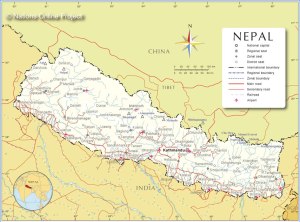For general information about the country profiles click here.
 Population: 27,474,377
Population: 27,474,377
HDI ranking: 157/187
HDI score: 0.463
Local government in Nepal is a challenge. The country is still largely centralized and there have been no elected local governments since 2002 (GDI, 2013; World Bank, 2014).
Local governance at a glance
- Nepal’s local government is divided into a middle tier of 75 districts each with a District Development Committee (DDC). Districts are sub-divided into 58 municipalities and 3,913 Village Development Committees (VDCs). VDCs are divided into wards and serve as the lowest level of service delivery in the system (GDI, 2013; World Bank, 2014).
- Kathmandu, the capital, is located in the Kathmandu valley with four other municipalities and numerous VDCs. There is no administrative provision for Kathmandu itself or the valley (UCLG, 2007).
- Municipalities and VDCs are directly elected and the head of administration is appointed by the Ministry of Federal Affairs and Local Development, which oversees all local bodies (MoFALD) (UCLG, 2007; World Bank, 2014).
- Forty Percent of nominated candidates for municipal council elections must be women (Quota Project, 2014).
Civil society actors
- At the district level, the GoGo Foundation has a network of Good Governance Clubs that advocate for accountable, transparent, and participatory governance (GoGo Foundation, 2014).
Capacity building institutions
- The Municipal Association of Nepal (MuAN) works on “ensuring a constitutional provision for autonomous local self-governments, the scheduling of overdue local elections, and the establishment of autonomous metro-cities and urban governments in the federal structure of Nepal.” MuAN provides technical and advisory support to make service delivery more efficient at the municipal level (MuAN, 2014).
- The Local Governance and Community Development Programme is being executed by MoFALD and supported by international development partners to improve service delivery, accountability and human resources capacity of local governance (LGCDP, 2014).
- The Local Governance and Accountability Facility (LGAF) is a semiautonomous body that emerged from the Local Governance and Community Development Programme. LGAF works to foster citizen engagement, and develop the capacity of marginalized groups and civic organizations to improve transparency and accountability in local government (LGAF, 2014).
- The Association of District Development Committees in Nepal (ADDCN) strengthens the capacity of DDCs “through information, advisory, training, technical and professional support and services” (ADDCN, 2014).
Fiscal control
- Municipalities receive grants and revenues collected by the central government. They can also tax for housing, land, rent, enterprises, vehicles, properties, entertainment, and impose service charges and fees (UCLG, 2007).
- DDCs receive budgetary transfers from the central government, can impose fees and service charges, and tax transportation routes and certain goods (UCLG, 2007).
- VDCs can tax housing, land, rent, markets, vehicles, businesses, and natural resources; they can also impose service charges and fees (UCLG, 2007).
Key initiatives for participatory local democracy
- The Decentralization Act of 1982 devolved responsibilities to the district level government (UCLG, 2007).
- After democracy was restored in 1991, three acts furthered decentralization reforms in 1992: the District Development Committee Act, the Village Development Committee Act, and the Municipality Act (UCLG, 2007).
- The Local Self Governance Act (LSGA) of 1999 allocated significant responsibilities in service delivery and mandated partial autonomy for decision-making and participation in local bodies (UCLG, 2007).
- The Local Governance and Community Development Program (LGCDP) currently works toward alleviating poverty through community-lead participatory development and the creation of inclusive, accountable and responsive local governments (GDI, 2013).
- By February 2015, Nepal aims to promulgate its new Constitution (Ranjitkar, 2104), which will include “a clarification of the roles and responsibilities for the tiers of local government, provisions for a more secure base for local elected officials” and more transparent and formula-based fund transfers (UCLG, 2010).
Challenges for participatory local democracy
- There have been no local elections since 2002 and local governments are instead administered by interim, unelected bodies that are run by bureaucrats appointed by the central government (GDI, 2013).
- Corruption is rampant in local government bodies and has seriously affected the ability of local governments to perform necessary service delivery functions, losing much of their legitimacy in the eyes of Nepali citizens (GDI, 2013).
- Although LSGA was considered a milestone, its major elements have not been implemented, local government funding is very low, and revenue collection is limited due to larger municipalities (UCLG, 2007; World Bank, 2014).
List of sources:
Association of District Development Committees in Nepal (ADDCN), 2014: http://www.addcn.org.np/.
German Development Institute (GDI), 2013, Mallik, V.: “Local and community governance for peace and development in Nepal.”
Good Governance (GoGo) Foundation, 2013: http://www.gogofoundation.org/.
Local Governance Accountability Facility (LGAF), 2014: http://www.lgaf.gov.np/.
Local Governance and Community Development Programme (LGCDP), 2014: http://www.lgcdp.gov.np/home/index.php.
Municipal Association of Nepal (MuAn), 2014: http://www.muannepal.org.np/.
Quota Project, 2014: “Nepal.”
United Cities and Local Governments (UCLG), 2007: “UCLG Country Profiles: Federal Democratic Republic of Nepal.”
United Cities and Local Governments (UCLG), 2010: “Local Government Finance: The Challenges of the 21st Century.”
World Bank, 2014, Farvacque-Vitkovic, C. and M. Kopanyi: Municipal Finances. A Handbook for Local Governments.”
